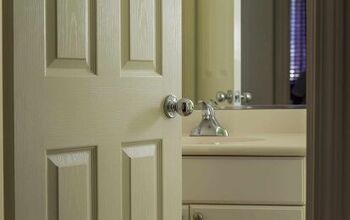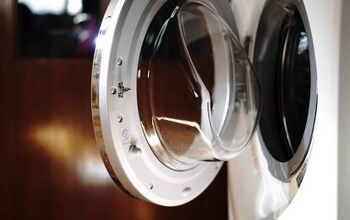How To Lock A Door Without A Lock (8 Ways To Do It!)

Locks serve one specific purpose: to keep people out. We have locks on many of the important things in our lives like our home, cars, and bedroom doors. But from time to time, those locks can become damaged and ineffective.
So, how do we keep a door locked without those locks? It may sound difficult, but it doesn’t have to be. There is a wide array of DIY options to go with. Use a fork to jam the door, a portable lock, and even build a barricade. These are just a few of the choices that you have to keep your door locked even when the locking mechanism has been broken.
How To Lock A Door Without A Lock
It is rare to find a door without a lock on it. Be it a home door or a car door, you can rest assured that there is a lock of some sort. But from time to time, those locks can break. When that happens, you may feel like you have no recourse.
Locks can break for a wide array of reasons. Perhaps the door got slammed too hard. Maybe there is rusting and weather damage. Whatever the case, living without a lock is not a viable option. Thankfully, there are a lot of different things that you can do to remedy the situation.
Method 1: Use a Fork
When you find yourself in an emergency situation – like needing a closet or toilet door locked – you can use household tools. Using something as simple as a fork, you can create a quick makeshift lock for short-term situations.
Start by getting a fork that you don’t mind getting bent. If you can find a metallic one, that is the optimal case. Shut the door, then slip your fork into the gap to test out the size. Depending on the size, it may fit fine or may stick out too far.
Bend the prongs. You can use a household tool to bend the prongs of the fork. Break the handle off and then stick the handle between the for prongs. This should secure the door lock into place. You can test this out by pulling the door towards the fork. If it holds, you are good to go. If it slips, you can use a rubber band to keep it in place.
Method 2: Get a Portable Lock
Portable locks come in handy for those who travel quite a bit. If you are in sales or just like to take a lot of trips, there is no doubt you have a portable lock in your possession. Those portable locks can come in handy at home or on the road when dealing with a door that won’t lock.
If you don’t own a portable lock, you can purchase one easily at the nearest hardware store. When you are in a pinch and your door lock has been broken, you can use a portable lock to get the job done. Having one on you can come in handy at a moment’s notice, so consider picking one up if you don’t have one already.
Method 3: Barricade the Door
When in doubt, you can simply block the door so that it won’t open. This is probably the most common way of locking a door without the use of a lock. It also requires the least effort and money since you won’t have to buy a lock.
Labor intensive. Building a barricade has a few downsides. The first is that it is probably the most labor-intensive option that you can go with. You have to put something heavy enough to keep the door shut, pulling it away whenever you want to open the door.
Can’t barricade from the outside. Barricades are great if you want to keep people out. But if you need to leave and don’t have locks, barricading isn’t really a good option. A barricade just blocks the exit, making it difficult or impossible to get into the room. Consider that if you pan on using a barricade.
Method 4: Commercial Barricade Device
Barricading the door seems like an effective principal. So, instead of lugging around heavy furniture, why not go with a product that was designed for just that kind of purpose? Barricades provide additional security and they are the failsafe when a lock stops working.
You can install one of these in your home by screwing it into the floor or using some type of plastic fastener. There are even finished options that can match your overall design aesthetic. Best of all, they are built to handle more force than you could imagine.
If you are looking for something more secure than a lock, which can break for a variety of reasons, then going with a commercial barricade device may be the best option. Get as much peace of mind as you could hope for with one of these.
Method 5: Jam the Door Shut
When you are in a punch, there are doorstoppers that you can use to temporarily jam the door shut. The great thing about these is that they are super cheap (usually under $5) and can be placed either on the top of the door or the side to keep it from slamming.
You can place the door stop at the top of your doorway as opposed to the bottom to make it act as a temporary lock. If you want to get truly hands-on, you can whittle down a stick that you find out in the yard. Use a knife block, shoe, or whatever else you need to jam the door shut.
Method 6: Tie the Door Handle Down
- Find a secure anchor. Should the lock be broken or you are dealing with a lockless door, you want something that will secure to the ground and will be able to support a heavy weight. A stair banister, pillar, decorative column, or even roofing beam should do the trick.
- Find a rope. Grab something that is rope-like. If you have a rope, that will work just fine. But you can also use old extension cords, braided rags, a gate chain, or a winching cable if you want to.
- Tie it. Now that you have the necessary tools, it is time to tie the rope off. Attach one end to the door handle, the other to your anchor. Make sure that you tie the “rope” off securely to prevent it from slipping off.
When the door is forced open, the “rope” will then tighten and keep the door from opening. This method works best on doors that open outward and it is especially useful on double doors since you can tie the two knobs together.
Method 7: Use a Chair
While this is pretty similar to the barricade option, it involves far less heavy lifting. Yeah, you can use heavy furniture to keep the door barricaded, but what if you could achieve the same amount of security with way less effort?
Use the backing of the chair to keep the lock from turning. All you have to do is tilt the chair backward, wedging the back so that it sits tightly underneath the lock. The chair prevents anyone from pushing the handle down from either the outside or inside, keeping the bolt in place.
It is important to note that there is one major caveat. It will only work on doors that have handles, not knobs. You can still use the chair to prevent the door from opening, but only if the door is an inward door. With a knob, the door can still open outwardly.
Method 8: Use a Belt
There are two instances where you can simply use a belt to secure a door with a broken or missing lock. The first is when the door comes with a door closer. The second is when the door comes with a hook ( bathroom doors, most likely).
Keeping the door closed. For most doors, all you have to do is stretch out the belt between the handle and the hook. When the belt is secure, the handle won’t be able to be pushed down, keeping the bolt in place. The most common application for this is on bathroom doors since a belt won’t really work without that hook.
For auto door closers. There are instances where the door may have an auto door closer. The most common locations for this sort of thing is an office, school, or some kind of commercial building. When those locks fail, you can secure the belt on the hinge to keep the door locked. It keeps the two arms of the door together snugly to keep the door from fully opening.
Replace the Lock as Soon as Possible
All of these are temporary solutions for a broken or missing lock. Depending on when you notice that the lock has been broken, you may not be able to do something about it right away. When you have the chance, buy a new lock and install it yourself or have a professional do the installation. Only with a professionally installed lock can you be certain that your door will stay shut securely.

Ryan Womeldorf has more than a decade of experience writing. He loves to blog about construction, plumbing, and other home topics. Ryan also loves hockey and a lifelong Buffalo sports fan.
More by Ryan Womeldorf














![The 5 Best Angle Grinders – [2022 Reviews & Buyer's Guide]](https://cdn-fastly.upgradedhome.com/media/2023/07/31/9071326/the-5-best-angle-grinders-2022-reviews-buyer-s-guide.jpg?size=350x220)












